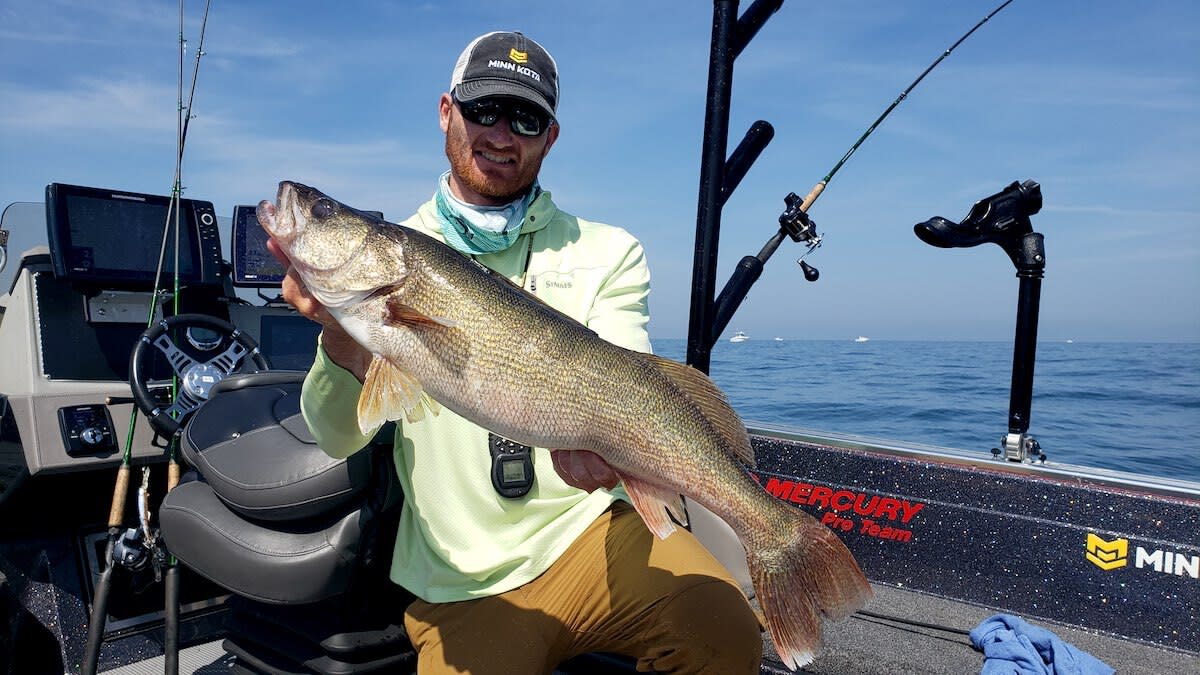
As the air conditioning units start to run regularly, you can almost bet that walleyes are settling into their summer patterns. On some bodies of water this means walleyes can be found shallow. On others, it means you need to look deep. On my home lake, it’s not uncommon for walleyes to be located in both areas. Here are three places to look for summertime walleyes and some of the best methods for getting them in the boat.
River Mouths Rising water temperatures will cause baitfish to head to river mouths where cooler water mixes into a warmer lake. Many biologists believe that fertile plankton, the foundation of the food pyramid, flowing out of a river is what baitfish are searching for.
This predictable congregation of baitfish can concentrate predatory fish in a small enough area that the old adage of shooting fish in a barrel might be appropriate. It should be noted that walleye will move in and out of these areas no differently than when they feed on other structure, so don’t be afraid to work the open water sections on the main lake as well.
In order to best intercept these feeding walleyes, troll crankbaits on planer boards. This will allow you to use multiple lines (where legal) and cover more water to take advantage of peak feeding windows. While walleyes will eat in the middle of the day when boat traffic is minimal, early and late in the day are still the best times.
A wide array of crankbaits can be effective, but first look at compact deep diving stick baits like the Northland Rumble Stick where smaller minnows are the predominant forage and the Northland Rumble Shad where perch, white bass, or shad are the preferred meal. Oftentimes, smaller is better under these conditions.
If there’s one thing I’ve learned, it’s that at this time of year speed kills—in a good way. Look to cook these crankbaits at speeds anywhere from 2 mph to nearly 3 mph. The extra throttle allows you to not only cover more water, but it also seems to cut down on the “undesirable bycatch” (small walleyes and trout) that slower speeds are more prone to bring.
Deep Points Steep ridges off main points in lakes and reservoirs are classic summer haunts. It may be that they act as current breaks or because they provide access to deep water close by. While even a poor paper map will show many of a lake’s underwater points, look into mapping cards for your GPS or sonar unit to see where the points dip closest to an old river channel or the deepest water. Areas where contour lines are angled and stacked up tight are dead giveaways at this time of year and typically the highest percentage spots.
When fish are feeding and most aggressive, look for them to be up on the point itself or on the contours adjacent the point. A bottom bouncer and a spinner such as a Northland Butterfly Blade rig with a full crawler is the perfect combination of power and finesse fishing. When boat pressure or a light bite occurs, skip the whole crawler rig and opt for just a small piece of a crawler on a Butterfly Super Death rig. The irregular tumbling of a small piece of a crawler can be almost too much for even the most lethargic walleye to pass up. It should be noted that the Super Death rig typically needs to be fished slower than the full crawler harness.
Less active fish or those pressured from boats can also be found suspended out off points and caught on the same techniques. In gin clear water, the addition of planer boards may be needed to get lines away from the boat.
Shallow Flats Shoals with compacted sand, rock, or weed bottoms are high percentage summer walleye spots. Waves crashing or weeds growing can bring higher oxygen levels and, much like the river mouths, create the start of the food pyramid. Fishing these types of flats is often slightly more difficult than the aforementioned locations because getting a lure in front of a fish without hanging up isn’t always the easiest thing to do.
Newer lure systems like the Northland Rippin’ Minnow allow you to fish aggressively with an artificial to trigger strikes from fish that aren’t quite what you’d call “aggressive.” The fin on the lure offers a gliding action similar to a horizontal ice fishing lure, but the Rippin’ Minnow has a large hook and the ability to rig it with a small- to medium-sized plastics that you can fish through weeds and rocks without hanging up. These heads work with live bait too.
When fish are located in small weed pockets, a weedless jig like the Northland Weed Weasel tipped with a live leech is a must. The weed guard helps keep the lure free and, when tipped with a lively leech, it draws strikes from walleyes. It’s also not as likely to be gobbled by “non-target species.”
When all else fails, the old slip bobber is worth dusting off. Not many other delivery systems can you get away from the boat and offer the ability to feed the most finicky fish. This can all be performed while suspending bait at the desired depth to avoid hang ups. A small jig, plain hook, or ice jig are deadly on the business end. Much like with the weedless jig, a lively leech stays on the hook securely and provides lots of action without the need to twitch it.
A lot of walleye anglers struggle to pattern summer walleyes. In reality, it can be one of the easiest times to put walleyes in the boat if you know where to look and what to do once you’ve found the school.



